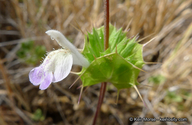Taxon Report
Acanthomintha ilicifolia (Gray) GraySan Diego thorn-mint |
 © 2013 Keir Morse |
Taxon Summary
Acanthomintha ilicifolia, commonly known as San Diego thorn-mint, is a annual herb in the Lamiaceae that is found in California and elsewhere. It occurs within Chaparral, Coastal scrub, Valley and foothill grassland, and Vernal pools, growing at elevations from 10 to 960 meters. Acanthomintha ilicifolia is ranked 1B.1, Plants Rare, Threatened or Endangered in California and Elsewhere; Seriously threatened in California.Classification
|
Scientific Name: |
Acanthomintha ilicifolia (Gray) Gray |
|
Common Name: |
San Diego thorn-mint |
| Family: | Lamiaceae |
| Element Code: | PDLAM01010 |
| USDA Plants Symbol: | ACIL |
|
Synonyms/Other Names: |
|
Ecology and Life History
| Lifeform: | annual herb |
| Blooming Period: Apr-Jun | Apr-Jun |
| Elevation: | 10-960 (35-3150) |
| General Habitats: | Chaparral, Coastal scrub, Valley and foothill grassland, Vernal pools |
| Microhabitat: | Clay, Openings |
| Microhabitat Details: |
Conservation Status
| CA Rare Plant Rank: | 1B.1 |
| Global Rank: | G1 |
|
State Rank: |
S1 |
| State List: | CE |
| Fed List: | FT |
| Other Status: | SB_CalBG/RSABG; SB_CRES |
|
CRPR Changes: |
|
Occurrence Data from the CNDDB
| Total Occurrences: | 84 |
| Element Occurrence Ranks: | |
| Excellent (A) | 5 |
| Good (B) | 23 |
| Fair (C) | 11 |
| Poor (D) | 7 |
| None (X) | 26 |
| Unknown (U) | 12 |
| California Endemic: False | |
| California Counties and Islands: Name (Code) | |
| San Diego (SDG) | |
| Quads: Name (Quad Code) | |
| Alpine (3211677), Del Mar (3211782), Dulzura (3211667), El Cajon (3211678), El Cajon Mtn. (3211687), Encinitas (3311713), Escondido (3311711), Imperial Beach (3211751), Jamul Mountains (3211668), La Jolla (3211772)*, La Mesa (3211771), National City (3211761)*, Otay Mesa (3211658), Poway (3211781), Ramona (3311617), Rancho Santa Fe (3311712), San Luis Rey (3311723), San Marcos (3311722), San Pasqual (3311618), San Vicente Reservoir (3211688), Tecate (3211656), Viejas Mountain (3211676) | |
Threat List Data from the CNDDB
| Threat List Total: | 20 | |
| EOs with Threat Listed: | Total EOs | % of EOs |
| 77 | 92 % | |
| Non-native plant impacts | 64 | 76% |
| Development | 52 | 61% |
| Foot traffic/trampling | 30 | 35% |
| Recreational use (non-ORV) | 27 | 32% |
| Road/trail construction/maint. | 27 | 32% |
| Improper burning regime | 26 | 30% |
| Other | 22 | 26% |
| Erosion/runoff | 21 | 25% |
| Vandalism/dumping/litter | 16 | 19% |
| ORV activity | 15 | 17% |
| Grazing | 11 | 13% |
| Wood cutting or brush clearing | 5 | 5% |
| Altered flood/tidal/hydrologic regime | 4 | 4% |
| Agriculture | 2 | 2% |
| Surface water diversion | 1 | 1% |
| Biocides | 1 | 1% |
| Feral pigs | 1 | 1% |
| Military operations | 1 | 1% |
| Mining | 1 | 1% |
| Non-native animal impacts | 1 | 1% |
Notes
| Approximately one third of the historical occurrences in CA have been extirpated; threatened by urbanization, road construction, vehicles, grazing, trampling, foot traffic, recreactional activities, erosion, and non-native plants. Several occurrences introduced (22B, 34C, 35B, 36D), but few have survived. See Proceedings of the American Academy of Arts and Sciences 8:368 (1872) for original description. |
|
Threats: |
|
Taxonomy: |
Selected References
| USFWS Critical Habitat (2008) On BIOS viewer |
| USFWS Critical Habitat Shapefile (2008) |
Citation
California Native Plant Society, Rare Plant Program. 2025. Rare Plant Inventory (online edition, v9.5.1). Website https://www.rareplants.cnps.org [accessed 23 December 2025].